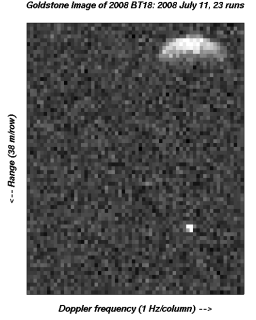Emily Lakdawalla • Jul 15, 2008
Buzzed by a binary
Yesterday, 600-meter-diameter asteroid 2008 BT18 and its 200-meter-diameter companion passed within about 2.3 million kilometers of Earth. This is both far away from us (six times the distance from Earth to the Moon and nowhere near as close as 2007 TU24 approached us in January) and unsettlingly close, reminding us of the fact that we live in a solar system shooting gallery. In an alternate universe where the orbital parameters of BT18 were fractionally different, it might have slammed into Earth, creating a 10-kilometer-diameter impact crater that released more energy than all the world's nuclear weapons combined (or so Doug Hamilton's Solar System Collisions website tells me). Fortunately, we don't live in that universe; we live in one in which, throughout human history, the worst known impact disaster was Tunguska, and in which BT18 passed by harmlessly. You can watch it fly by in this neat video from amateur astronomer John Drummond.
You can learn lots more about the BT18 flyby over at Astroprof, and more about asteroid near misses from the blog entry I wrote in January about TU24. Using the NEO program close approaches search tool, I find that since TU24 passed within 1.4 lunar distances of Earth on January 29, there have been more than 50 close approaches that were closer than BT18's miss distance of 5.9 lunar distances, including one (2008 EF32) that got within 0.2 lunar distances from us! Instead of lunar distances, close orbits like that merit comparison with the orbital altitude of geosynchronous satellites, which is about 42,000 kilometers above Earth's center. EF32 passed us at a little less than double the geosynchronous altitude. For one more little bit of context, the asteroid Apophis will pass closer to Earth than the geosynchronous altitude in 2029. Approaches that close are fortunately pretty rare.
That we know anything about BT18 other than its nearness is owed largely to the great Arecibo radio telescope. Optical telescopes could spot and track BT18. Arecibo is powerful enough to determine its rotation rate, (vaguely) show its shape, tell us its size, and demonstrate that it is a binary. It was discovered to be a binary in Arecibo observations from July 6 and 7. Here's the latest image from Arecibo, produced on July 11; you can get lots more information on the BT18 observations on this page by radio astronomer Lance Benner.
The Planetary Society is working hard to advocate for continued funding for Arecibo and for other near-Earth object-related programs. If you'd like to help us, the best way is to vote with your wallet.
Let’s Go Beyond The Horizon
Every success in space exploration is the result of the community of space enthusiasts, like you, who believe it is important. You can help usher in the next great era of space exploration with your gift today.
Donate Today

 Explore Worlds
Explore Worlds Find Life
Find Life Defend Earth
Defend Earth


